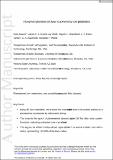A Long‐Lived Planetesimal Dynamo Powered by Core Crystallization
Author(s)
Maurel, Clara; Bryson, James F. J.; Shah, Jay; Chopdekar, Rajesh V.; T. Elkins‐Tanton, Linda; A. Raymond, Carol; Weiss, Benjamin P.; ... Show more Show less
Download10.1029-2020GL091917.pdf (850.3Kb)
Open Access Policy
Open Access Policy
Creative Commons Attribution-Noncommercial-Share Alike
Terms of use
Metadata
Show full item recordAbstract
The existence of numerous iron meteorite groups indicates that some planetesimals underwent melting that led to metal-silicate segregation, sometimes producing metallic cores. Meteorite paleomagnetic records suggest that crystallization of these cores generated dynamo magnetic fields. Here we describe the magnetic history of the partially differentiated IIE iron meteorite parent body. This is the first planetesimal for which we have a time-resolved paleomagnetic record constrained by 40Ar/39Ar chronometry spanning several tens of million years (Ma). We find that the core of the IIE parent body generated a dynamo, likely powered by core crystallization, starting before 78 ± 13 Ma after solar system formation and lasting at least 80 Ma. Such extended core crystallization suggests that the core composed a substantial fraction of the body ( urn:x-wiley:00948276:media:grl61991:grl61991-math-0001 13%–19% core-to-body radius ratio depending on the body’s radius), indicating efficient core formation within some partially differentiated planetesimals.
Date issued
2021-02-11Department
Massachusetts Institute of Technology. Department of Earth, Atmospheric, and Planetary SciencesJournal
Geophysical Research Letters
Publisher
American Geophysical Union (AGU)
Citation
Maurel, C., Bryson, J. F. J., Shah, J., Chopdekar, R. V., Elkins-Tanton, L. T., Raymond, C. A., & Weiss, B. P. (2021). A long-lived planetesimal dynamo powered by core crystallization. Geophysical Research Letters, 48, e2020GL091917.
Version: Author's final manuscript
ISSN
0094-8276
1944-8007